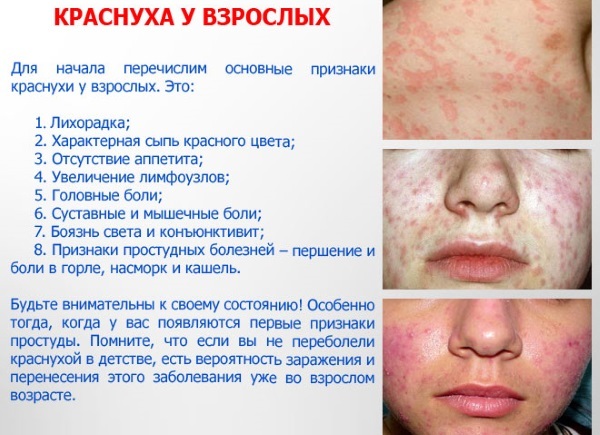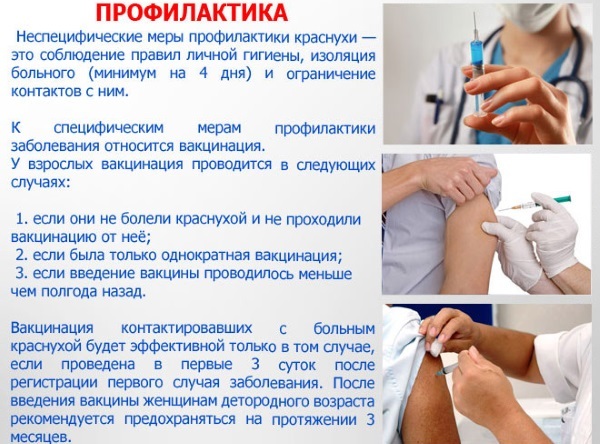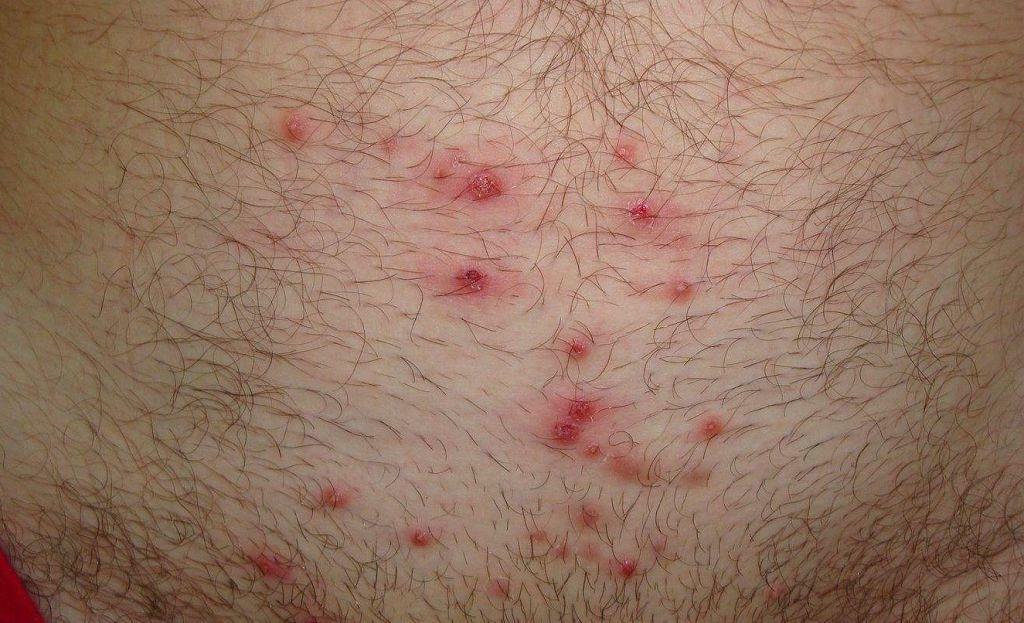Many people rubella is associated with children, since most of this infectious disease is manifested at an early age. But if the person is not ill with the disease in childhood, then the probability of infection persists throughout life.
However, in adults the pathological process takes place in severe complications. Therefore, when the first symptoms should consult a doctor and undergo treatment that will help prevent more serious health problems.
The content of the article:
- 1 The causative agent of the disease
- 2 Modes of transmission
- 3 incubation period
- 4 mechanisms of disease development
- 5 Course of the disease in pregnant women
- 6 Symptoms typical form
- 7 Severity of disease
- 8 atypical form
- 9 Subclinical rubella
- 10 methods of diagnosis
- 11 rubella treatment
- 12 The consequences for the body
- 13 Prevention of rubella
- 14 Vaccination against measles
- 15 vaccines
- 16 Video of rubella in adults, its symptoms and treatments
The causative agent of the disease
The disease develops as a result of penetration into the body with a certain virus ribonucleic acid in the composition.
The causative agent is a member of the genus Rubivirusov and belongs to the family Togaviridae. Its feature is the ability to agglutinate erythrocytes to each other, and destroy them using the enzyme proteins.In addition, the virus has the neuraminidase enzyme that negatively affects the nervous tissue. pathogen virus size is 60-70 nm. On top of it is covered with a coat protein fibers that helps him to be attached to the healthy cells.
Pathogen resistant to environmental conditions, therefore destroyed in the presence of the following factors:
- ultra-violet rays;
- change the acidity level below 6.8 and above pH 8.0;
- treatment with disinfectants;
- Increased content of temperature (over 30 degrees);
- reacting with ether or formalin.

rubella virus is able to withstand freezing to -60-70 degrees, preserving viability for 30-40 days and stored at room temperature for 8-10 hours. At risk are people aged 21-30 years, especially women, in the future the probability of infection is greatly reduced.
Modes of transmission
Virus infectious nature can be transmitted in two ways:
- an airborne transmission of infections (acquired form);
- transplacental infection, that is, with the blood flow through the placenta (congenital form).
The virus is transmitted by direct contact with a patient and is considered typical anthroponoses. Any other ways the disease is not spread, so it can not become infected through contaminated water, food or the animals.
In the absence of strong immunity which could be achieved by vaccination, the likelihood of infection upon contact with a virus is 60-80%. The sick person is to surround the greatest danger during the last week of the incubation period, and 10-12 days after the rash has acted on the body.
incubation period
The most favorable conditions for the development of the disease is the low temperature and high humidity. Therefore, most of the infection is diagnosed in autumn and winter. The incubation period for rubella is 11-25 days, but in some cases, the progression of the disease occurs within 16-20 days.
At that time, people did not even know that he is infected with HIV and therefore do not carry out any remedial measures.

The disease is characterized by a period of eruptions, which lasts 3-4 days. A feature of rubella is that people, once an infection has transferred, can not re-infected due to lifelong sustainable immunity.
mechanisms of disease development
Once the virus is in the body the disease goes through several stages of development. Initially, the infection affects the nasal tissue cells and larynx. After that, moving on and switches to the neck and mandibular lymph nodes, where they begin to proliferate. After 1 week after the virus enters the bloodstream it spreads throughout the body.
Within a week after the skin appears red spots. They testify to the appearance of the protective body in the body. In the future, their number will increase, which will help to overcome the virus. The patient recovers completely in the next 2-3 weeks. The period depends on the individual.
Course of the disease in pregnant women
The most dangerous virus for pregnant women, because it can be transmitted to the fetus through the placenta. As a result, possible damage to any organ of the child, but more often it provokes the development of cataracts, heart disease and deafness.
Also congenital rubella virus can cause the following complications in the baby:
- a significant reduction in the skull, which ultimately prevents the full development of the brain;
- mental retardation;
- diabetes;
- abnormal enlargement of the liver and spleen size;
- partial necrosis of cardiac muscle tissue;
- encephalitis;
- impaired development of bone tissue;
- pneumonia;
- delay in the development of all organs and systems.
Pathological effects of the virus is able to manifest itself in the form of a miscarriage (30%), stillbirth (20%) and the loss of a baby during childbirth (20%).

Depending on the age of the infected women fetal loss occurs in the following ratio:
- 1 week of pregnancy - 80%;
- 2-4 week - 60-65%;
- Week 5-8 - 30-35%;
- Week 9-12 - 10-12%.
As the growth of the fetus risk of infection is greatly reduced, but even at 5 months there is a chance of infection for 1 child out of 10 cases. Rubella in a pregnant woman is often the main indication for abortion.
Symptoms typical form
Rubella in adults, symptoms which may indicate a mild or severe form, can have different effects on the human body. It is on the basis of these signs of an expert and establish a diagnosis, and assigns the necessary course of therapy.
characterized by the following symptoms for a typical rubella:
- The characteristic rash. Initially, it appears on the face, and then spreads throughout the body. The rash is a red spot, 5-7 mm in diameter, rising above the unaffected skin. This is caused by the toxic effects of the virus on the small blood vessels located near the epidermis. The spots have clear boundaries and merge with each other. The most noticeable rashes on the elbow and popliteal fossa, lower back, buttocks and upper back. Spustya2-3 day spots disappear without leaving any trace.
- Low-grade fever. Man feels slight discomfort, which is expressed in muscle ache and general weakness. Body temperature is persistently kept at around 37 degrees. But in some cases diagnosed increase to 40 degrees, the temperature can not bring down any antipyretic drugs.
- The increased size of lymph nodes. 2-3 days after infection inflamed cervical, occipital, parotid, inguinal lymph nodes. And a certain dependence of the development of the pathological process can not be traced. On palpation the inflamed areas the pain is felt.

- Headache. In 90% of diagnosed cases of measles in adults accompanied by migraine attacks. Remove the pain is not even painkillers. This symptom significantly affects the patient's state of health and completely knocks him out of the rut.
- Symptoms of the common cold. The patient is observed constant runny nose and nasal discharge. After the defeat of the larynx appears dry cough and sore throat. In the propagation of the virus in the conjunctiva appears watery eyes, pain in the eyes, photophobia.
- Stains on the palate. Subsequently, the patient is the same rash in the mouth, as well as on the body. However, palpation no pain does not occur.
In men, the penetration of rubella virus may cause pain in the testicles. To reduce the unpleasant feeling encouraged to adhere to bed rest. But in the process of healing the painful symptom passes without causing any harm to health.
Severity of disease
Rubella in adults, the symptoms of which differ from the above, is the cause of serious health complications, indicative of severe pathology.
Possible complications for the body:
- Reduced blood clotting against the backdrop of the toxic effects of the virus. This may indicate: prolonged and heavy menstruation, not typical for women, hematuria, bleeding gums, the presence of large number of small bruises on the skin.
- Encephalitis. As a result, the penetration of the virus in humans there is inflammation of the brain, the disease development can occur after the disappearance of the characteristic rash. In this case, the patient's state of health sharply deteriorates, possible loss of consciousness, coma, partial loss of motor skills, severe migraine. In some cases, encephalitis, rubella in the background is the cause of death of the patient.
- ArthritisAgainst the background of viral infection of the joints. After the disappearance of the rash on day 2 person feels pain and swelling of the extremities. Unpleasant symptoms persists for 5-10 days.
atypical form
Rubella in adults, the symptoms of which first manifested in the form of a red rash, is not characteristic of the atypical form of the disease.

In this case, the patient has only the following pathological signs:
- cough;
- compulsive runny nose;
- nasal;
- sore throat;
- increased size of lymph nodes.
On the basis of these symptoms physician is often confused with the common cold rubella, as the characteristic red spots on the body not. Identify rubella only for suspected contact with an infected person.
Subclinical rubella
Rubella in adults who have no symptoms, is considered to be subclinical disease. In this case, the patient has no clue about the presence of the virus in the body. In this case, it is dangerous to others, so it remains a source of further infection.
Subclinical measles diagnosed 4 times less compared to typical. The doctor is able to recognize the pathology examination of only appointing a person contacting the patient.
methods of diagnosis
a comprehensive examination of the patient is carried out to establish the diagnosis. First the doctor makes examination of the patient for the presence of a set of core symptoms: rash, runny nose, cough, photophobia, lacrimation. Subsequently, the patient is carried out a survey on the possibility of contact with an infected person.
The following examination methods are assigned for accurate determination of the diagnosis:
- General blood analysis. When a virus is detected decrease in the total number of white blood cells responsible for protective immunity and response.
- Serological. Inspection is carried out 2 times with intervals of 10 days to identify the amount of antibodies in the blood. In case of an increase of their contents, due to the reaction of the organism to effect the virus can be considered a confirmed diagnosis indirectly. Often the preferred enzyme immunoassay.
- Virological Method. This method of diagnosis is based on detection of the virus in the body and its subsequent neutralization. However, due to the need to use expensive equipment, this diagnostic method is not widely used.
- Molecular-genetic method. It is the most acceptable way of confirming rubella at 1-4 day after the virus enters the body. To identify RNA viruses use any biomaterial: saliva, washing away from the nasopharynx, urine, blood plasma.

In addition, the differential diagnosis to exclude pathologies having a common clinical picture:
- measles;
- hives;
- erythema infectious properties;
- Pink zoster;
- adenoviral infection;
- mononucleosis;
- enterovirus infection.
Based on the identified data doctor confirms or refutes the diagnosis, and optionally assigns complex therapy.
rubella treatment
In the case of rubella, the human body is capable of and equipped to deal with the virus, so antivirals are not assigned. Therefore, treatment is directed primarily to improvement of human health and disease elimination of unpleasant symptoms.
The main types of drugs used as a symptomatic therapy:
- antipyretics (Acetaminophen, Aspirin, Nurofen). Use of these drugs might in the case of high temperature, accompanying the development of pathology.
- antihistamines (Suprastin Laurent). Help reduce the allergic reaction of the organism to the toxic effects of the virus.

- antiprotozoal agents (Chloroquine). Appointed to prevent the development of arthritis on a background of rubella. The principle of operation is based on a partial suppression of the immune system as well as inflammation of the joints do not develop under the effect of the virus, and against the background of excessive amounts of antibodies in the blood.
- glucocorticoids - preparations synthesize hormones of the adrenal cortex. Used in case of a lack of platelets in the background of the introduction of the virus into the body. The use of these drugs can reduce the pathological process.
Hospitalization of the patient is carried out in the event of an epidemic risk and severe disease.
In these cases, the statement is held a week after the appearance of the characteristic rash. If there is no risk of infection surrounding the treatment of rubella on an outpatient basis. For a quick recovery patient is prescribed bed rest and drinking plenty of fluids fluid.
The consequences for the body
The greatest danger is the virus poses to women during pregnancy, since provokes the development of a variety of fetal malformations. This circumstance leads to choose between forced abortion and the birth of a baby with abnormalities. Since the birth defects caused by rubella, can not be disinfected.
In adult patients, the most dangerous symptom of rubella is the inflammation of the brain, as well as disorders of the nervous system functions. As a result of the virus encephalitis causes depression of the cardiovascular system than can lead to respiratory arrest.
In the case of adverse effects on the CNS partial or complete paralysis can occur, which ultimately can cause death. Often you can find the assertion that the rubella virus can lead to infertility in both women and men, but the actual confirmation of this theory and have not found.
Prevention of rubella
The only reliable prevention against infection with the rubella virus is vaccination, as it generates immune to the pathogen. However, this method does not give a lifetime warranty. Therefore, all adults should periodically be tested for the presence of blood IgG and IgM type antibodies. In their absence, vaccination should be repeated.

For non-specific preventive measures also include temporary exclusion of contact with a carrier of the disease and careful personal hygiene. The sick person should be isolated from others and make sure you have immunity to the disease in all family members, which would require to hand over analyzes.
Otherwise, otherwise it is a danger to their health. In the case of the presence of the family of a pregnant woman, her contact with the virus carrier should be restricted for a longer period - for the entire period of the disease and another 2 weeks after recovery.
Vaccination against measles
The vaccine against rubella can be simultaneously carried out and in measles and mumps at the age of 1-1.5 years and 6 years. This procedure is free of charge and is held in the medical institutions of the place of residence. But sometimes parents, for fear of imaginary side effects, do not give a permit to carry it out, and this endangers the health of their child.
In adult women vaccination is recommended at age 22-30 years, because at this age intensifies the desire to have a baby. Vaccination men can spend up to 40 years, to reduce the further spread of infection, and protects women and children with whom they come into contact. Vaccination saves the human immune system for over 10 years.
Special preparation before the procedure does not exist, but at the same time, experts recommend to follow some recommendations:
- This organism propensity for allergic reaction requires 2 days prior to grafting to take antihistamine according to the age dosage.
- People with weakened immune systems should be within 7 days prior to the procedure to conduct admission fortifying preparations, coordinating it with the doctor.
- On the day of vaccination is not recommended to tightly breakfast.
- After the procedure should not leave the clinic immediately. Within half an hour the patient must remain under the supervision of medical staff, which will help to provide timely treatment in case of allergy.
- Within a week after the vaccination should be wary of new products, as well as the need to limit the intake of fatty foods.
- After the procedure, it is recommended to drink plenty of fluids because it helps to eliminate toxins from the body.
- After inoculation for 1 week not to consume alcohol, as this prevents the development of sustainable immunity to the pathogen.

Permissible body's reaction to the vaccine, which is not a cause for concern:
- slight redness, swelling and pain in the injection site;
- the temperature in the range of 38-39 degrees for 2-3 days;
- the presence of the common cold, sore throat, otitis media, and pain in the eyes;
- rash over the body, resembling spots rubella and measles, which runs its own within 2-3 days.
vaccines
In medicine it is permissible to use the following types of rubella vaccine:
- triple - MMR II, Priorix;
- single component - Rudivax, Ervevax.
Pregnant women vaccination is contraindicated, so the procedure is recommended to perform at least 3 months prior to conception.
Poses no danger at an early age Rubella is an infectious disease, but adult pathology is accompanied by symptoms of complicated and can lead to serious problems with health. So do not ignore the timing of the vaccination, as it is a reliable protection of the organism.
Video of rubella in adults, its symptoms and treatments
Specialist treatment and consequences of rubella in adults:
Fragment of the program "Live healthy" for rubella:



